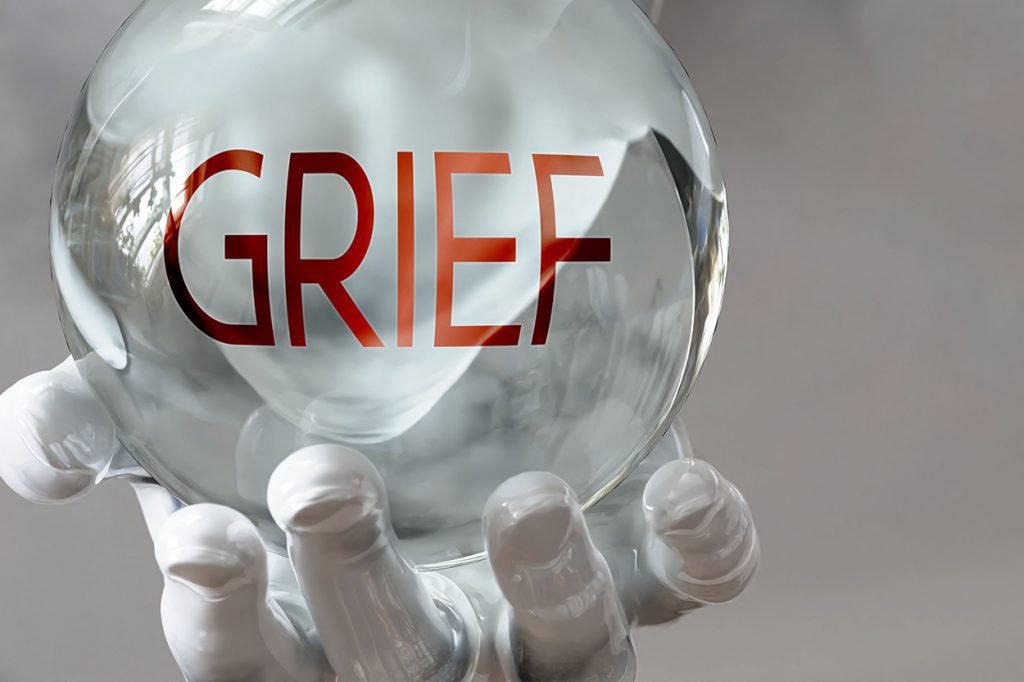By Bethany Bray
Centuries after it was first uttered, clients in counseling may still hesitate to “speak ill” of someone in their life who has died. It’s natural, however, for human grief to involve a range of thoughts and feelings — not all of which will frame the deceased in a positive light. This is all the more true when the person who died had an abusive, rocky, strained, unsupportive, toxic or absent relationship with the client.
“Having conflicted feelings about the deceased happens more often than is discussed,” says Elizabeth Crunk, a licensed graduate professional counselor who specializes in helping clients with grief and loss at her private practice in Washington, D.C. “There’s a societal expectation that we don’t speak ill of the dead, and I think that sometimes can keep people even from seeking counseling.”
That hesitancy can be compounded when the client is worried about how a counselor might react to their situation. It isn’t uncommon for clients to assume that a practitioner will judge them negatively or expect them to forgive the deceased if they are struggling with mixed feelings about the person’s death, Crunk explains.
“It’s important [for counselors] to validate those coexisting feelings. It is possible to feel both sorrow and joy,” Crunk says. “Also, it’s important to validate [a client’s] feelings of numbness or not feeling sad. Assure them that they don’t necessarily need to conjure up sadness if that’s not genuinely what they feel.”
It’s complicated
The emotions that clients experience in response to the death of a person with whom they had an unhealthy relationship are certainly complicated. However, the term complicated grief is a specific psychological diagnosis (also called prolonged grief disorder) that involves lengthy, extended grief that often is accompanied by intense emotional pain and longing for the deceased, as well as maladaptive behaviors such as disbelief that the person actually died. (For more, see our 2014 article “The complicated mourner.”)
It is possible that clients who have lost someone for whom they have mixed feelings will experience complicated grief. However, Crunk says, the experience is perhaps more likely to fall under the definition of disenfranchised grief — a type of grief that is unsupported or unrecognized by society or culture.
Clients who don’t feel “sad” in the traditional sense about a death may believe that their experience is not socially acceptable. Such mixed feelings can be especially common when the death has a certain stigma attached to it, such as with deaths due to suicide or drug overdose, says Karin Murphy, a licensed professional counselor (LPC) who specializes in grief work at her Doylestown, Pennsylvania, private practice. Counselors who work in the addictions field or with clients whose loved ones battle addiction may hear clients disclose these types of feelings, she notes. Regardless of specialty, counselors may encounter clients using language that minimizes their loss (even when they feel the loss acutely) if they sense any stigma connected to the person’s death.
“It’s really important for counselors not to perpetuate that disenfranchisement. [A client’s grief] is supported, recognized and valid,” Murphy says.
The disenfranchised grief these clients experience “doesn’t allow room for them to express the range of what they’re feeling — especially relief,” adds Crunk, a member of the American Counseling Association and a courtesy assistant professor in the counseling department at George Washington University in Washington, D.C.
Such circumstances can spur conflict even within family networks, Crunk says. One or more family members may have had a good and loving relationship with the deceased, whereas other members of the family may not have. In these cases, family discussions about how, or whether, to memorialize and remember the deceased can be fraught with tension.
The death of a parent, spouse or other person who was abusive, neglectful or invalidating toward a client can result in a grief process that is difficult for others to understand or accept, says Mark Tichon, an LPC who is an associate professor and counseling program director at Lincoln Memorial University in Tennessee.
“The relief that can accompany the passing of an abuser is hard to discuss without seeming callous,” says Tichon, a member of ACA. “In these cases, strong contradictory feelings of longing for a [healthy] relationship and the burden of guilt at the sense of relief may result in a grieving process that is marginalized and not socially validated.”
Related emotions
Clients who seek counseling for a range of issues could be struggling with this type of unprocessed grief without being able to name it or disclose it themselves at intake. Counselor clinicians can listen and watch for a number of emotions that commonly dovetail with struggles over the loss of a person for whom the client had a complicated or unhealthy relationship.
In Murphy’s experience, shame, relief and guilt are most commonly expressed by these clients. Feeling a sense of relief that a person is gone often causes clients to question what that means about them.
“It’s feeling release, but [clients] have a very difficult time naming that. ‘What does that say about me if I’m relieved that this person has died?’ And with that relief comes shame,” Murphy says. Clients may struggle with, “What’s my part in this? What did I do to contribute to this sense of unfinished business? And the would haves, could haves, should haves that come from that.”
In addition, Crunk notes that these clients may express self-blame, anger, numbness or ambivalence over the loss. They may grapple with feeling unsettled or unresolved about certain aspects of their relationship with the deceased. They may feel grief centered not on the loss of the actual person but on the loss of a relationship that never was or of what might have been, Crunk adds.
Murphy urges counselors to remember that complicated feelings can also occur when clients experience nondeath losses, such as a change in someone who is no longer themselves because of dementia, addiction, chronic illness or other conditions. A conflicted relationship does not go away when the person begins to change because of illness, she points out. In fact, clients’ emotions may be exacerbated if they are pushed into a caregiving role.
“Understand that loss may not involve death. Life is really a series of losses, but a lot of times we don’t think about grieving, or giving ourselves permission to grieve, unless there’s been an actual death of a person,” says Murphy, who is certified in thanatology and has past experience as a hospice bereavement coordinator. “A lot of times, we have feelings about things, but we’re not really told or given space to understand that not only is it OK to feel that way, but we might expect to feel that way. That’s where the disconnect happens — feeling too much or too little. And that’s what brings [people] into counseling.”
In session, Crunk begins to explore the client’s feelings surrounding their loss with questions about the relationship the client had with the deceased. She asks the client to describe what life with the person was like. If there is any indication of conflicted feelings on the part of the client, she follows up with more gentle questioning.
“I ask them early on to talk about their relationship with the person [who died]. I try to open the door a little bit for them to share if there is some ambivalence. I don’t want to push that too hard but [simply] open the door. I want to assure them that they don’t have to speak positively all of the time,” Crunk says. “Even with deceased loved ones that we had a good relationship with, there are always aspects that we didn’t like, or things we didn’t agree with. I always try and leave room for that side of the coin.”
“Sometimes what comes up too is that we start our work and the client thinks that they had a pretty positive relationship [with the deceased], but as we begin to dig deeper into the story, other more complicated aspects arise,” adds Crunk, who co-authored a 2017 Journal of Counseling Development article, “Complicated Grief: An Evolving Theoretical Landscape,” with Laurie A. Burke and E. H. Mike Robinson III.
This was the case with one of Crunk’s clients who grew up with a mother who was abusive. In counseling, the client needed help processing the death of her father. At first, the client identified her father as a protective figure, but as she worked through the loss in counseling, she began to voice feelings of disappointment that her father hadn’t done more to remove her from an abusive situation. At that point, Crunk recalls, their counseling work shifted to processing the client’s newly discovered feelings about her father.
Grief has many layers, but that is especially so for clients who have conflicted feelings, Tichon says. “One thing clients may need to do with a compassionate and humanistic counselor is grieve the loss of having an ideal parent, for which many clients hold hope as they grow older, or grieve the loss of hoped for reconciliation that will never come.”
Tichon once worked with a man who struggled acutely with the loss of what could have been. The client’s father, who had narcissistic personality traits, died “just as their relationship was starting to become more of an adult friendship where [the son] could exert healthy boundaries that allowed him to genuinely enjoy their time together,” Tichon says. The client’s father had died suddenly, so there was no chance to say goodbye or find closure.
“It took a long time for him to reconcile the conflicting emotions of sadness over the death of his father with the feeling of freedom from parental judgment and punitive emotions,” Tichon says. “One key goal of therapy was for this client to resolve feelings of guilt over the relief that his dad was no longer in his life. At the end of our time together, this client was able to say thoughtfully, ‘I still miss him, but I’m also relieved he’s out of my everyday life for good’ with a sense of peace.
“The tension between feelings of loss over what could have been a meaningful adult relationship, anger and resentment over emotional neglect during his childhood and adolescence, and guilt over feelings of relief that the relationship was finally over had resolved to … greater clarity and peace as he became more fully accepting of these intense and contradictory feelings.”
Unwrapping
Grief work should always be tailored to the specific needs of the client, but that becomes especially important with those who are navigating mixed emotions about the deceased. As a counselor who specializes in grief and loss, Crunk may have five clients who are experiencing the same type of loss — the death of a parent, for example. But as Crunk points out, each client will have different aspects of the loss that they struggle with and need to process.
To narrow the focus, Crunk encourages clients to identify what is “most troubling” to them about the loss. If the loss was traumatic or unexpected, that may be the aspect that is most troubling to them, she explains. But for other clients, it could be feelings of guilt or shame surrounding a person’s death.
One of Crunk’s clients was mourning the loss of her grandchild. The client had experienced a troubled upbringing herself, but as an adult, she had endeavored to create healthy and safe family dynamics for her own children and grandchildren. As their work in counseling progressed, it became clear that the client was grieving the loss of her identity as a loving grandparent as much as the death of her grandchild.
“I had assumed that losing her first grandchild was the worst of it. But when I asked her what was the most painful, she said, ‘I worked really hard to cultivate a healthy, stable life, and now I’ll never have that perfect life.’ She had lost that part of her narrative: She no longer had a ‘perfect’ life,” Crunk recalls. “It’s important [for counselors] to put personal assumptions aside. What you assume is the most troubling [aspect] may not be. Let the client dictate, and spend the most time on that.”
Helping clients give voice to the complicated feelings that accompany a loss is among the most important things that a counselor can do, says Tichon, who is scheduled to co-present a session, “Complicated Grief: Treatment Stories and Experiential Exercises,” at ACA’s Virtual Conference Experience in April. Tichon has past experience as a geriatric counselor and would sometimes hear clients express a range of feelings that they had held on to for years regarding a loss.
One client, a woman in her 80s, had lost her husband two decades prior but still harbored resentment because he had been emotionally punitive, controlling and physically abusive early in their marriage. In counseling, she needed to process both the loss of her husband and the pain he had caused her.
“She grew up in an era when people often did not discuss their marital problems outside of the home. At the beginning of addressing this topic in therapy, she had a lot of guilt and shame about ‘talking bad about him,’ as she had some religiosity about needing to honor her husband,” Tichon recalls.
As their counseling work progressed, the client grew in her ability to verbalize her feelings of hurt and sadness and, in turn, process the abuse her husband had perpetrated. Only then was she able to focus on some of the more positive feelings she had toward her husband, Tichon says. As a result, her depressive symptoms lessened, and her life narrative became much more positive.
“He had been dead for 20 years, but her unexpressed resentment had [been] pent up in her all those years. … She made a breakthrough in the process of grief when she was able to voice that although the physical abuse had ended when she was in her 30s, she held contempt and emotional distance [for her husband] through the end of the marriage. At 83 years old, she wound up owning her own part in a bad marriage, and in a faith-based, spiritual way, asked for forgiveness for not accepting his remorse and validating that, in some ways, he was a changed man [while] he was still alive,” Tichon says. “In short, grief needs to happen, and when we allow the depth of the process to work through in what is often long-term therapy, we deeply heal.”
Making meaning
Expressive therapies can be particularly useful in helping clients make meaning of losses that involve mixed feelings. Exercises such as writing a letter to the deceased can be especially helpful when clients feel that things were left unfinished or unhealed in the relationship. However, work should be client led, and interventions must be used only when appropriate.
“Writing a letter to the deceased person — highlighting the happy moments, the resentment, anger and sadness that the relationship caused, and unrealized dreams and hopes — and reading that letter using empty chair work can help integrate these emotions into the personality,” Tichon says. “I find that when using the empty chair technique, if I have the client mindfully visualize the person sitting there, down to remembering mannerisms and clothing of the object of their grief, it makes the experience particularly impactful. I would rule out this depth of visualization, however, if the deceased was particularly abusive. I would not engage the client in this level of visualization of the abuser, as the intervention is significantly deep. In cases like this, venting strong emotions and giving voice to unresolved anger and hurt is, in itself, very cathartic.”
Bernadette Joy Graham, an LPC who specializes in grief and loss at her Maumee, Ohio, private practice, uses a similar technique, prompting clients to use their imagination to create a space where they can visualize meeting the person who died and speak with them to find closure. This can be a real place, such as a room in their childhood home, or a setting that holds meaning for the client. Graham lost her mother when she was a teenager, and she uses this technique herself, imagining a front porch where she can sit down with, see and speak with her mother whenever she feels the need to.
Crunk also uses various correspondence exercises, including letter writing, journaling, the empty chair technique and other imagined dialogue techniques, with her clients. She says this work allows clients to say things they wish they had said while the person was still alive, apologize if they feel that is needed, work through complicated emotions and process unresolved conflict.
“The end goal is about revising their self-narrative and their narrative of the relationship with that person that brings a little more repair and helps things feel a little bit more integrated,” Crunk says. “I use a lot of attachment-informed meaning reconstruction techniques to help them create a coherent grief narrative.”
In sessions, she also looks for nonverbal cues that might indicate that a client needs to explore something further. If a client shows signs of agitation, for example, she’ll ask them to name what they’re feeling.
“If I see tears, I ask, ‘If these tears could talk to you, what would they be saying?’ If they say, ‘I feel a heaviness in my chest when I talk about this person,’ I might ask them to put a hand on their heart, and I might mirror that with my own hand,” Crunk says. “Then, I’ll ask them to describe that heaviness. Does it have a shape? Does it have an image? It’s all with an aim of them being able to tolerate that.”
Crunk is using telebehavioral health with her entire caseload during the coronavirus pandemic and acknowledges that picking up on nonverbal cues from clients can be more challenging. However, she believes that “it’s all the more important to show that I’m present, that I’m there with them, offering a place to cry or feel anger or relief, whatever it is.”
Some grief counseling techniques may need to be adjusted slightly when used with clients who did not have a good relationship with the deceased, Crunk notes. This is the case with empty chair, letter writing and other expressive techniques. The goal of these techniques is not to have clients reimagine their narratives regarding the person — for example, by pretending that the abuse never took place or that the person never lapsed into addictive behaviors. Rather, the goal is to help them reconstruct their narrative of their relationship with that person and, potentially, accommodate any new insights about the person who died or their relationship with that person into their current awareness or schemas. Sometimes, Crunk explains, when “conversing” with the person who died, the client stumbles upon a new insight about that person or their life that helps the client see their relationship with that person from a different perspective — one that can potentially help the client make more sense of their loss or bring them some calm.
These techniques are meant to offer clients a pathway “to revise the relationship in a way that they can carry it with them but that does not put pressure on the client to transform it into something that is unrealistic or fictional,” Crunk explains. “It helps the client imagine a world where there is an opportunity to receive an apology or hear words that they yearned to hear the person say.”
Clients sometimes express doubt about whether the deceased person loved them or struggle with things that went unsaid or undone while the person was alive, Murphy notes. She urges counselors to help clients find creative ways of expressing or completing what was “left undone.” For instance, counselors can leverage anything that a client enjoys as a hobby — writing poetry, painting, making collages — to help them communicate thoughts that are uncomfortable or to explore things that went unfinished between themselves and the deceased.
The simple act of writing down a thought, even if it gets tucked away in a desk drawer or journal, validates what the client is feeling and acknowledges that they are working through it, Murphy says. She sometimes recommends that clients read licensed mental health counselor Stephanie Jose’s book Progressing Through Grief: Guided Exercises to Understand Your Emotions and Recover From Loss, which features journal prompts throughout the text.
“Getting the thoughts and feelings out of your head and having a container for them is going to bring relief. It allows clients to process these feelings but also separate themselves from them and put them in a separate place than their mind,” Murphy says. “There is a common misconception: If I just give it enough time, I’m going to feel better. In reality, it’s time plus what you do that will help.”
In addition to encouraging expressive therapies, Murphy often suggests that clients seek out grief support groups so that they can connect with others going through similar experiences. Doing volunteer work can sometimes help clients address things that they feel they didn’t accomplish with the person who died, she adds. For example, they may not have been able to reconcile with an older relative before that person passed away, but they can forge connections with other older adults by volunteering at a nursing home or similar setting.
Similarly, counselors can help clients create new rituals to mark the passing of someone for whom they have mixed feelings. This can be done privately on their own, or with the practitioner in session. It can involve anything from making a donation to a cause that is important to the client or was important to the deceased, to eating at a restaurant that the client associates with good memories about the deceased.
Tichon agrees that expressive and creative therapies can be particularly helpful with clients who are “stuck” or need to process hurtful feelings regarding a loss. In one technique, Tichon has clients rip off a piece of paper for each emotion or painful memory that they express in session regarding the deceased.
“At the end of this exercise, the client is often in tears and staring at a shredded pile of paper, deeply in tune with the feelings of pain and brokenness. We then process how this piece of paper won’t look like what it did before we started, but we can use it to build something new. And in grief, things won’t be the same [either], but they can be good again,” Tichon says.
Tichon then directs clients to take their shreds of paper home and use them to create something that speaks to their hopes for the future. “This has been a particularly powerful experiential intervention, and clients have brought back art and murals that serve as metaphors for moving forward and building new meaning in life,” he says.
Leaning in
Counselors might find themselves experiencing the urge to comfort clients who are struggling with difficult emotions related to the death of someone who inflicted pain upon them, Crunk notes. While these clients need support, they also need to gradually work through the discomfort they feel regarding the loss.
“Grief, as painful as it is, it’s my belief that it needs to be felt. It can become complicated, but in general, for the vast majority of people, it’s not a disorder. [It’s] an emotion that needs to be felt and honored. I try and create a space for the person to emote and hold that grief [in a] container for them. I don’t want to press too hard, but I encourage them to lean in to it, to be able to expand their tolerance and sit with their grief,” Crunk says. “It’s a delicate balance because, as much as I want to provide comfort, if that’s all that I do, then nothing will change. … We want so badly to help [our clients] and provide support and comfort. It can feel counterintuitive in grief counseling, but sometimes the most helpful thing to do is to help them increase that capacity to feel their grief. As painful as it is, it’s a necessary part of healing.”
That delicate balance involves helping clients access and sit with their feelings of grief and find ways to take respite from their grief, pursue restoration or give themselves permission to feel positive emotions, Crunk adds.
Clients who are struggling with a painful, complicated loss sometimes ask how soon they will feel better or get through it. Making promises to these clients that everything will eventually be fine is not appropriate, Graham asserts. Although it is natural for counselors to want to “fix” these clients, practitioners must push back against that urge, she says.
“Be honest with the client and say, ‘This will never be easy, and you might never have [complete] closure,’” Graham advises. “I give them as much support as possible, but I never say, ‘It’s going to be OK.’ I say, ‘I don’t know how long this will take. Everyone’s different and everyone’s unique. There is commonality in grief, but no two experiences are the same.’”
Murphy acts as a gentle guide for clients as they lean in to their uncomfortable feelings related to grief. “I often tell clients, ‘We’re doing this in bite-size pieces … because it’s too big to do all at once.’ I hear this a lot from my clients: ‘It’s been three months, and no one wants to hear me talk about this [anymore]. Why aren’t I over it?’ A lot of [this] is realizing that grief has no timeline.”
Murphy says clients often need to give themselves the following permission: “I have every right to grieve this. It matters to me, and it’s going to take as long as it takes.”
Instilling self-compassion and focusing on self-talk can make an important difference for clients struggling with disenfranchised grief, she says. “Finding the self-compassion to sit with what you need to allows you to move past it,” Murphy says. “I often hear from clients, ‘If I let myself cry, I’m never going to stop.’ I [say to clients], ‘Let’s test that out. When was a time when you allowed yourself to feel something, and did that last forever?’ It’s a lesson that feelings come and go, but they’re not here to stay.”
Forgiveness and compassion
Clients who harbor feelings that go against cultural norms — such as feeling relief that a family member has died — need a safe space to voice those feelings. Tichon urges counselors to “wear their best Carl Rogers hat” when working with these clients and to remember the principle of unconditional positive regard.
“Allowing the client to experience the full range of conflicting emotions, and providing the depth of a supportive, nurturing and nonjudgmental environment — which the client often has not experienced — can allow deep healing to occur. … Clients may have feelings of longing and sadness, but also betrayal, anger and contempt. It is helpful to extend compassion and allow clients to explore and express the fullness of those conflicting emotions and grieve the loss of the ideal parent, spouse or significant attachment figure who they never had. [This can result] in validation of feelings [that are] contrary to cultural messages on grieving.”
Murphy also emphasizes the need for practitioner compassion with these clients. “Maybe they’ve never had anyone ask them how they’ve felt about the loss. That can go a long way, and it opens the door to get them to talk about it,” Murphy says. “Validation [of the client’s feelings] is the important first step.”
“A big concern [that clients voice] is ‘What’s wrong with me? Why am I feeling this, and why can’t I get over this?’ And the answer is because you’re human,” Murphy continues. “When we’re doing this type of work, the relationship — that therapeutic alliance — is the most important. We can talk about tools, but the most important thing is that the person is feeling heard and acknowledged. … What we [counselors] can bring is to be present during that pain and allow the space [to process it]. That’s what it’s all about: Just being validated is the most important thing, and then figuring out from there what tools are needed, because it’s so individualized.”
Graham says that “empathy goes a long way” with these clients and also stresses the need to keep the work client led. Prior to intake, she explains to clients that the assessment process will take the entire session and that she will be asking about subjects that may stir up difficult feelings. “Don’t assume that they know what assessment is and how it works,” Graham says. “They may not realize that they’re going to have to disclose past trauma, assault” or other painful issues.
A gentle approach on the part of the counselor can prevent clients’ anxiety from spiraling, Graham says, especially if they aren’t familiar with the therapy setting. This can mean the difference between a client returning to counseling or dropping out, she says. “I tell the client, ‘There will be a lot of serious questions that are going to take you back in time. If it gets too emotional, we can stop and take a break,’” says Graham, who previously worked at an inpatient rehabilitation center for clients with substance dependence. Graham also stays mindful during sessions and steers the conversation to lighter topics toward the end, while leaving time for questions from the client. If appropriate, she finishes with a joke to get the client laughing. “They are going to have to go home and function [after session],” Graham says, “[so] I try and close the wound back up a little.”
Another aspect of this work with which counselors must tread lightly is the issue of forgiving the deceased, Crunk says. This too must be client led. Forgiveness is sometimes an outcome of grief counseling, but it should never be imposed by a counselor, she stresses.
“I would never pressure a client or use that type of language unless they bring it up. If, through the work, they find more compassion or empathy toward the person, [that can be a positive outcome], but I just don’t feel that should come from me. It’s not a goal that I would impose on the work,” Crunk says. “There are ways that positive psychology can lead to growth and positive outcomes, but we also have to be careful how we use them. Clients can react, understandably, negatively if they feel their counselor is trying to get them to find beauty in their grief or goodness in their relationship. We have to be careful that it doesn’t feel forced [by] us.”

Grief and doing your own work
Counselors are human, which means that they will experience personal losses throughout their career. Hearing clients talk about the different painful emotions related to the death of a loved one can be triggering for practitioners if they haven’t fully processed their own feelings regarding a loss in their life.
“It’s hard,” acknowledges Karin Murphy, a licensed professional counselor (LPC) with a practice in Doylestown, Pennsylvania. “Counselors have to do their own work [to process loss]. Oftentimes, counselors are not able to talk about it [a client’s grief or loss] because of their own history. It’s an important component of grief counseling: We have to do our own work so we’re able to let that come into the room.”
Ohio LPC Bernadette Joy Graham recently experienced the death of someone close to her, and she stepped away from her counseling practice for a brief time to mourn and process the loss.
“The counselor really has to have themselves rooted with all of their losses,” Graham says. “No matter how well-trained you are as a grief counselor, grief in your own life will be hard.”
As it relates to counselor grief, the 2014 ACA Code of Ethics cautions against practitioner impairment. Professional counselors are called to “monitor themselves for signs of impairment from their own physical, mental, or emotional problems and refrain from offering or providing professional services when impaired.”











